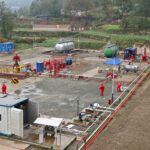Skid-mounted equipment is integrated and modular. Its material selection directly affects stability, service life, and safety in different conditions.
304 stainless steel, 316 stainless steel, 316L stainless steel, and 2205 duplex steel are common choices. Their composition differences—especially in Cr, Ni, Mo, C, and metallographic structure—shape their corrosion resistance, mechanical properties, and uses.
This article breaks down these four materials by “characteristics, performance, suitable conditions, and considerations” to explain their application logic.
I. Core Principles for Material Selection
Choosing materials for skids depends on three key factors:
- Medium traits: Check for corrosive components like chloride (Cl⁻), hydrogen sulfide (H₂S), acids/bases (pH), or organic solvents.
- Environmental parameters: Note operating temperature (-270℃~650℃), pressure (atmospheric to high), and thermal cycles.
- Processing needs: Consider if welding or bending is required, and if long-term maintenance-free operation is needed.
II. Detailed Analysis of Four Materials
1. 304 Stainless Steel (18Cr-8Ni, Austenitic)
Composition
18% chromium (Cr), 8% nickel (Ni), no molybdenum (Mo). Carbon content ≤0.08%. Single austenitic structure for good ductility.
Key Performance
- Corrosion resistance: Only works in mild environments. Handles air, fresh water, and room-temperature neutral solutions (e.g., industrial cooling water). Fails in Cl⁻, H₂S, strong acids (pH<4), or strong alkalis (pH>12)—prone to pitting or stress cracking.
- Mechanical strength: Tensile strength ≥515MPa at room temperature. Elongation ≥40%. Weakens at >300℃ but stays tough at <-196℃.
- Processability: Easy to weld, bend, and polish. Lowest cost among the four.
Suitable Skid Conditions
- Ordinary industrial skids: Fresh water circulation, room-temperature air compression, non-corrosive storage.
- Civil/light chemical use: Food processing (non-acidic), municipal sewage pre-treatment (neutral water).
Notes
- Avoid Cl⁻ environments (seawater, brine). Pitting may occur in 1-3 months.
- Welded parts need solution annealing to prevent intergranular corrosion (critical for 50-250℃ use).
2. 316 Stainless Steel: Better Than 304 With Molybdenum
316 adds 2%-3% molybdenum (Mo) to 304, making it 18Cr-10Ni-2Mo (carbon ≤0.08%). Mo forms a denser oxide film (Cr₂O₃+MoO₃) to block Cl⁻.
Key Advantages Over 304
- Corrosion resistance: Handles low Cl⁻ (e.g., desalinated water, <5% acids, sulfur <1% gases). Critical pitting temperature (CPT) is 50℃ vs. 304’s 25℃.
- Temperature adaptability: Stronger than 304 at <400℃. Works for medium-temperature skids (e.g., <350℃ steam systems).
Suitable Skid Conditions
- Moderately corrosive industrial skids: Chemical transfer (ethanol, glycol), low-sulfur oilfield water treatment, offshore fresh water cooling.
- Food/pharmaceutical use: Acidic food processing (ketchup, juice), weak chemical mixing.
Notes
- Not for high Cl⁻ (concentrated brine) or high sulfur (H₂S>1%).
- Costs 30%-40% more than 304. Balance corrosion needs with budget.
3. 316L Stainless Steel: Low-Carbon 316
316L is 316 with lower carbon (≤0.03%, “L” for low carbon). Other components match 316 (18Cr-10Ni-2Mo). Lower carbon prevents Cr₂₃C₆ formation during welding, avoiding intergranular corrosion—no extra annealing needed.
Key Advantages Over 316
- Welded corrosion resistance: Welds match base material. Ideal for large welded skids (e.g., multi-pipeline systems, pressure vessels).
- Low-temperature toughness: Elongation ≥45% at -196℃. Better than 316 for low-temperature skids (liquid propane storage, gas separation).
Suitable Skid Conditions
- Welded moderate-corrosion skids: Chemical reactors, oilfield sour gas treatment (H₂S≤1%), low-temperature LNG auxiliaries.
- High-purity scenarios: Pharmaceutical GMP transfer skids, semiconductor ultra-pure water systems.
Notes
- Corrosion resistance matches 316 at room temperature. Costs only 5%-10% more.
- Avoid >450℃—low carbon reduces high-temperature strength.
4. 2205 Duplex Steel (22Cr-5Ni-3Mo-N)
2205 has the best corrosion resistance and strength. It contains 22% Cr, 5% Ni, 3% Mo, and nitrogen (N). Structure is 50% ferrite + 50% austenite—combining toughness and strength for extreme conditions.
Key Performance (Surpassing Other Steels)
- Corrosion resistance:
- Handles high Cl⁻: CPT ≥60℃. Works with seawater, brine (Cl⁻>10,000ppm), and 10%-20% acids.
- Resists high sulfur: Withstands H₂S>10% (e.g., high-sulfur gas fields, refinery sour water). Far better than 316L.
- Mechanical strength: Tensile strength ≥620MPa (1.2x 304). Yield strength ≥450MPa (2x 304). Good for high-pressure skids (>10MPa).
- Stress corrosion resistance: Rarely cracks in Cl⁻+tensile stress (e.g., thermal cycle pipelines). Lasts 3-5x longer than 316L.
Suitable Skid Conditions
- Extreme corrosion: High-sulfur gas field skids (Puguang multiphase drainage), offshore platforms (seawater cooling, oil-gas treatment).
- High-pressure + high corrosion: Refinery catalytic cracking skids (high pressure + Cl⁻ + H₂S), 20MPa chemical reactors.
Notes
- Costs 80%-100% more than 316L. Use only for extreme conditions (H₂S>5% or Cl⁻>5,000ppm).
- Hard to process: Welding needs strict heat control (avoids single-phase structure). Bending requires attention to springback.
III. Comparison Table of Material Adaptability
| Material | Core Corrosion Resistance | Applicable Media/Environments | Typical Skid Scenarios | Cost (vs 304) | Service Life (Normal Conditions) |
|---|---|---|---|---|---|
| 304 Stainless Steel | Air, fresh water, neutral solutions | Tap water, room-temperature air, non-corrosive materials | Fresh water circulation, civil equipment | 1x | 5-8 years |
| 316 Stainless Steel | Low Cl⁻, weak acids/bases, low sulfur | <5% acids, desalinated water, sulfur <1% gases | Chemical transfer, light chemical reaction skids | 1.3-1.4x | 8-12 years |
| 316L Stainless Steel | Low Cl⁻, no post-weld corrosion | Acidic foods, pharmaceuticals, sulfur ≤1% low-temp media | GMP skids, low-temp gas separation | 1.4-1.5x | 10-15 years |
| 2205 Duplex Steel | High Cl⁻, high H₂S, high pressure | Seawater, H₂S>10% gas, high-pressure acids | High-sulfur gas fields, offshore platforms | 2.2-2.4x | 15-25 years |
IV. Conclusion: How to Choose
- Assess corrosion level:
- Mild (fresh water/air) → 304.
- Moderate (low Cl⁻/sulfur) → 316 (no welding) or 316L (welding).
- Extreme (high Cl⁻/sulfur/pressure) → 2205 duplex steel.
- Check extra needs:
- Welding required → 316L (avoids intergranular corrosion).
- Low temperature → 316L. High pressure → 2205.
- Balance cost: Skip 2205 for non-extreme conditions. 316L works for most chemical skids at half 2205’s cost.
This logic ensures skids meet performance needs with the longest life and lowest cost.



